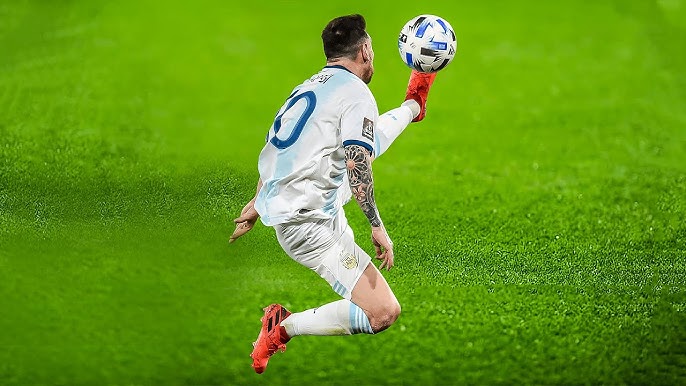How to Curve a Soccer Ball
Scoring jaw-dropping goals in soccer often requires more than just power. By curving or “bending” the ball, players can finesse shots around defenders and catch goalkeepers off guard.
Mastering how to make the ball curve opens up creative new attacking opportunities.
While physics is involved, curving a soccer ball effectively starts with proper technique. Certain steps in your run-up and strike can greatly accentuate the ball’s curve.
With experimentation also comes intuition – eventually, you’ll develop a feel for exactly how much spin to apply.
Let’s break down the full process step-by-step:
The Set Up
Before swinging at the ball, optimal positioning sets the foundation for an accurate strike.
Run Up: Take 3–4 strides leading into the ball at a 90-degree angle from your target. Keep your body leaning slightly forward through the final stride to generate momentum.
Plant Foot Placement: Place your non-kicking foot about 6 inches from the ball, angled slightly away from your target. This allows room for your kicking leg to wrap around.
Balance: Slightly bend the knee of your plant leg while keeping the opposite arm outstretched for stability.
The proper setup keeps you balanced through the strike. Now for the fun part—making the ball curve!
Striking the Ball
Applying a sidespin makes the soccer ball bend post-contact. Here’s how to put lots of rotation on it:
Strike the Side: Kick the left or right hemisphere of the ball rather than the absolute center. This imparts an angled rotation.
Hit it Low: Aiming for the bottom half adds lift through the Magnus Effect (more on this later).
Lock the Ankle: Keep a rigid ankle joint through contact to transfer force cleanly from foot to ball.
Use the Sweet Spot: The zone between your laces and inside foot transfers the most spin.
Refine these dynamics until you find your ball curves like a rainbow at just the right intensity for your purpose.
Generating Maximum Spin
Certain body motions during the swinging and follow-through enhance spin:
Extend the Backswing: Initiate from as far back as comfortable to build momentum—think maximum pendulum arc.
Lean Over the Ball: Keep your chest inclined forward rather than back as contact occurs.
Drag the Plant Foot: Allow your plant foot to either leave the ground or drag as the kicking foot follows across.
Open the Hips: Pivoting your opposite arm and hips accentuates the twist to induce extra rotation.
This coercive twisting expends more energy but imparts a wicked bend!
Types of Curved Kicks
Applying a sidespin proves highly versatile for multiple standard soccer scenarios:
Corner Kicks: Bend a ball right towards the front of the goal around a wall of defenders.
Free kicks: Finesse shoots up and over the wall or swerves the ball past outstretched arms.
On-Target Shots: Curve your shots around keepers and defenders for higher percentage scoring opportunities.
Now to harness this curvature where it counts – accurately placing your shots.
Aiming Your Curved Shot
The Magnus effect causes spinning balls to curve perpendicular to their rotation. Therefore, you must account for the bend when lining up shots:
Gauge how much your kick normally curves and the spin required for the amount of bend you desire.
Aim to the left or right of your actual target based on which way you will curve the ball.
Practice judging curve intensity; experiment with different spins to refine the aim.
Here are some detailed instructions, progressions, variations, and safety considerations on “How to Curve a Soccer Ball.”
Mastering the Basics
Before attempting to curve shots in game situations, it’s important to drill the proper technique.
The Side-Volley Drill
Setup:
Place a cone or pole about 10-15 yards away from the ball as a target
Approach the ball at a 90-degree angle 3-4 strides out
Instructions:
Plant your non-kicking foot 6 inches to the side of the ball, pointing your toes out at a 45-degree angle
Keep your ankle locked and strike the lower right side of the ball with your instep
Maintain balance by bending your plant knee and keeping your opposite arm out
Make contact below the midline of the ball to give it lift
Follow through, dragging your plant foot as you wrap your kicking leg around
Progressions:
Attempt drill from both left and right approach angles
Increase distance to target
Try alternating between regular and curved contact on every rep
Safety Tips:
Warm up calf, hip, and gluteal muscles thoroughly before attempting
Ensure adequate space between other players
Use a slightly deflated ball when first learning the technique
This drill grooves the muscle memory for solid curved ball contact.
Applying Bend in the Attacking Third
Now to put that curve to use in attacking scenarios:
The Double Cone Drill
Setup:
Place two cones or poles about 10-15 yards apart, a few yards from the touchline
Set up a ball 20 yards straight out from the middle point between the two cones
Instructions:
Dribble towards the ball at an angled approach
-Curve your shot around the outside of one cone, bending it back in towards the opposite cone
Work from various entry angles and approach speeds
Progressions:
Attempt to bend the ball around the opposite cone
Position a teammate or coach between the cones as an obstruction
Practice drills on both the left and right sides
Safety Tips:
Ensure adequate space for an angled dribbling approach
Check behind the shooting area is clear
Use a slightly deflated ball if new to the curving technique
Now integrate this bending effect directly into your attacking tactics.
With a dedication to sound technique and safety, curving the soccer ball can soon come naturally!
With mastery over spin comes mastery of placement. Now unleash the true creative potential of your kicks!
Scoring the most spectacular goals involves some curve appeal. Mastering the sidespin technique unlocks new attacking dimensions to your game. So try these steps, let physics take the wheel, and let that soccer ball bend to your will!
Related Post: How To Play Soccer. The Ultimate Beginner’s Guide
AUTHOR: Michael Cunningham

Michael Cunningham is a professional football player and YouTube football trainer. He provides drills, tutorials, and other videos to help a soccer player improve.
Instagraminstagram.com/7mlctraining
Facebookfacebook.com/michaellewiscunningham
Twittertwitter.com/cunnygoesham
Website7mlctraining.com
Learn also here





